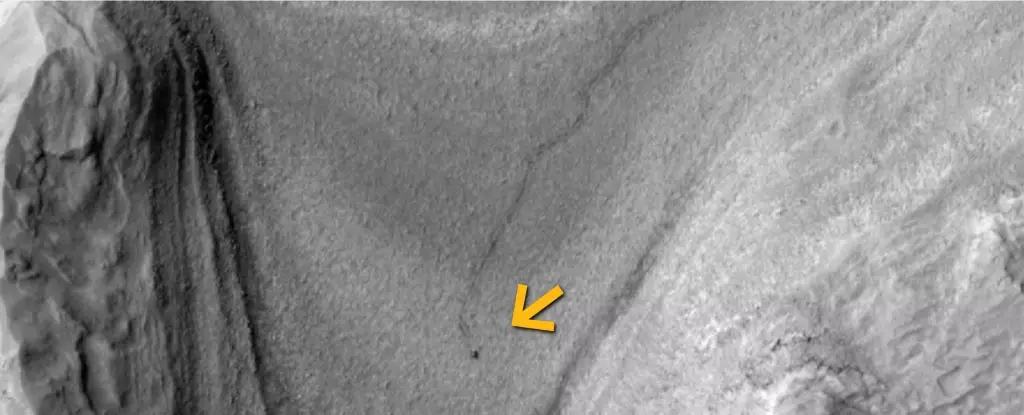Launched in 2011 and landing on the Martian surface in August 2012, the Curiosity rover has become a symbol not just of technological advancement, but of humanity’s unyielding quest for knowledge. Set against the backdrop of the desolate Gale Crater, Curiosity operates in complete isolation, steadfastly unraveling the geological and aqueous history of a world that, while starkly different from our Earth, bears tantalizing hints of shared origins. The recent imagery captured by NASA’s Mars Reconnaissance Orbiter serves as a poignant reminder of this fragile yet tenacious exploratory mission.
Visual Documentation of Exploration
In a groundbreaking moment for space exploration, the Mars Reconnaissance Orbiter successfully photographed Curiosity as it charted the raw landscape of Mars. The striking photograph shows the rover as a mere speck on a vast terrain, highlighting its unrelenting spirit amidst a landscape where time seems to stand still. The image immortalizes the meandering tracks left behind—approximately 320 meters long—showcasing a journey that may seem trivial to human eyes but is monumental for robotic discovery. This visual documentation speaks not only to the incredible advances in space imaging technology but also to the emotional resonance of a solitary machine dedicated to unveiling the mysteries of another planet.
The Mechanisms of Exploration: A Slow and Steady Approach
Curiosity’s comparatively slow speed—about 160 meters per hour—may seem excruciatingly sluggish in the fast-paced context of our daily lives. However, this deliberate pace is a calculated strategy engineered by necessity. Moving cautiously allows the rover to optimize its power consumption and navigate the treacherous terrain of Mars more safely. With its 110-watt nuclear generator, Curiosity avoids the perils of faster speeds that might risk damage or battery depletion. The rover’s mission is not a race; rather, it is a testament to the patience required for genuine scientific inquiry.
A Landscape of Discovery
The Gediz Vallis channel, where Curiosity recently traversed, offers a geological narrative that continues to captivate scientists. The channel is believed to have been sculpted by massive floods that swept across the Martian surface, leaving behind geological clues that could unlock past climatic conditions believed to have been more favorable for life. In a stunning twist, Curiosity encountered a deposit of pure sulfur, igniting excitement and intrigue in the scientific community. What does this discovery mean? Is it a sign of past microbial life or merely an indicator of aquatic activity long ago? The answers remain elusive but tantalizingly close.
Exploring Boxwork Formations: A New Frontier
Curiosity is not just a mechanical rover; it is a window into Martian landscapes that might parallel Earth’s geological features. As it approaches the boxwork formations at the base of Mount Sharp, the anticipation builds. On Earth, these delicate patterns emerge when groundwater leaves minerals along fracture lines, altering the landscape over millennia. If similar processes occurred on Mars, the implications could be transformative for our understanding of the planet’s potential for ancient microbial life. This kind of geological analysis embodies the intersection of Earth-bound science and extraterrestrial exploration.
The Broader Implications of Martian Research
Beyond the thirst for knowledge, Curiosity’s voyage raises profound existential questions: What does it mean to explore? What is our responsibility to other worlds? As scientists analyze Martian rocks and soil, they are not just gathering data; they are in a dialogue with the cosmos, revealing the intimate connection between Earth and its neighboring planet. The meticulous endeavors of Curiosity represent the essence of human resilience and determination—traits that echo through both the roar of rockets and the whispers of ancient dust on the Martian wind.
Martian exploration reminds us that each day Curiosity operates is another chance for discovery, a small but significant step on a path that may one day lead humanity to the stars. As we reflect on this robotic pioneer, we recognize not just its contributions to science, but its role as a harbinger of hope and curiosity in an uncertain universe.

